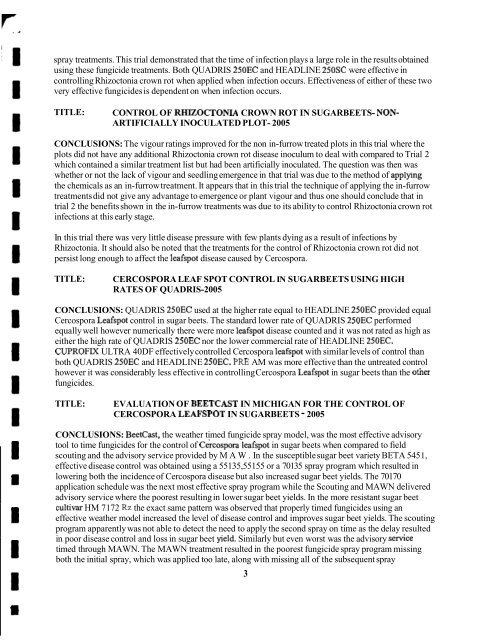ontario sugar beet growers - Atrium - University of Guelph
ontario sugar beet growers - Atrium - University of Guelph
ontario sugar beet growers - Atrium - University of Guelph
You also want an ePaper? Increase the reach of your titles
YUMPU automatically turns print PDFs into web optimized ePapers that Google loves.
spray treatments. This trial demonstrated that the time <strong>of</strong> infection plays a large role in the results obtained<br />
using these fungicide treatments. Both QUADRIS 250EC and HEADLINE 250SC were effective in<br />
controlling Rhizoctonia crown rot when applied when infection occurs. Effectiveness <strong>of</strong> either <strong>of</strong> these two<br />
very effective fungicides is dependent on when infection occurs.<br />
TITLE:<br />
CONTROL OF RFIJZOCTONIA CROWN ROT IN SUGARBEETS- NON-<br />
ARTIFICIALLY INOCULATED PLOT- 2005<br />
CONCLUSIONS: The vigour ratings improved for the non in-furrow treated plots in this trial where the<br />
plots did not have any additional Rhizoctonia crown rot disease inoculum to deal with compared to Trial 2<br />
which contained a similar treatment list but had been artificially inoculated. The question was then was<br />
whether or not the lack <strong>of</strong> vigour and seedling emergence in that trial was due to the method <strong>of</strong> applyng<br />
the chemicals as an in-furrow treatment. It appears that in this trial the technique <strong>of</strong> applying the in-furrow<br />
treatments did not give any advantage to emergence or plant vigour and thus one should conclude that in<br />
trial 2 the benefits shown in the in-furrow treatments was due to its ability to control Rhizoctonia crown rot<br />
infections at this early stage.<br />
In this trial there was very little disease pressure with few plants dying as a result <strong>of</strong> infections by<br />
Rhizoctonia. It should also be noted that the treatments for the control <strong>of</strong> Rhizoctonia crown rot did not<br />
persist long enough to affect the leafspot disease caused by Cercospora.<br />
TITLE:<br />
CERCOSPORA LEAF SPOT CONTROL IN SUGARBEETS USING HIGH<br />
RATES OF QUADRIS-2005<br />
CONCLUSIONS: QUADRIS 250EC used at the higher rate equal to HEADLINE 250EC provided equal<br />
Cercospora Leafspot control in <strong>sugar</strong> <strong>beet</strong>s. The standard lower rate <strong>of</strong> QUADRIS 250EC performed<br />
equally well however numerically there were more leafspot disease counted and it was not rated as high as<br />
either the high rate <strong>of</strong> QUADRIS 250EC nor the lower commercial rate <strong>of</strong> HEADLINE 250EC.<br />
CUPROFIX ULTRA 40DF effectively controlled Cercospora leafspot with similar levels <strong>of</strong> control than<br />
both QUADRIS 250EC and HEADLINE 250EC. PRE AM was more effective than the untreated control<br />
however it was considerably less effective in controlling Cercospora Leafspot in <strong>sugar</strong> <strong>beet</strong>s than the otner<br />
fungicides.<br />
TITLE:<br />
EVALUATION OF BEETCAST IN MICHIGAN FOR THE CONTROL OF<br />
CERCOSPORA LEAFSPOT IN SUGARBEETS - 2005<br />
CONCLUSIONS: Beetcast, the weather timed fungicide spray model, was the most effective advisory<br />
tool to time fungicides for the control <strong>of</strong> c&cospora leafspot in <strong>sugar</strong> <strong>beet</strong>s when compared to field<br />
scouting and the advisory service provided by MAW. In the susceptible <strong>sugar</strong> <strong>beet</strong> variety BETA 545 1,<br />
effective disease control was obtained using a 55135,55155 or a 70135 spray program which resulted in<br />
lowering both the incidence <strong>of</strong> Cercospora disease but also increased <strong>sugar</strong> <strong>beet</strong> yields. The 70170<br />
application schedule was the next most effective spray program while the Scouting and MAWN delivered<br />
advisory service where the poorest resulting in lower <strong>sugar</strong> <strong>beet</strong> yields. In the more resistant <strong>sugar</strong> <strong>beet</strong><br />
cultivar HM 7 172 Rz the exact same pattern was observed that properly timed fungicides using an<br />
effective weather model increased the level <strong>of</strong> disease control and improves <strong>sugar</strong> <strong>beet</strong> yields. The scouting<br />
program apparently was not able to detect the need to apply the second spray on time as the delay resulted<br />
in poor disease control and loss in <strong>sugar</strong> <strong>beet</strong> yeld. Similarly but even worst was the advisory service<br />
timed through MAWN. The MAWN treatment resulted in the poorest fungicide spray program missing<br />
both the initial spray, which was applied too late, along with missing all <strong>of</strong> the subsequent spray<br />
3

















